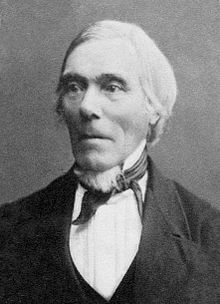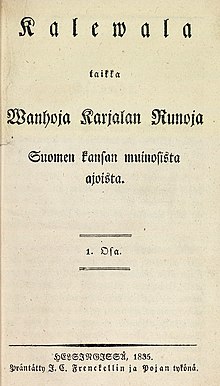Elias Lönnrot
![]()
Lönnrot is a redirect to this article. For the asteroid of the same name see (2243) Lönnrot.
Elias Lönnrot [![]()
![]() ˈɛlias ˈlœnruːt], also Lö(n)nrot(h) (b. 9 April 1802 in Sammatti, Sweden; † 19 March 1884 ibid., Russian Empire) was a Finnish writer, philologist, and physician. During his travels in Finland and East Karelia he recorded Finnish folk poetry handed down orally, on the basis of which he wrote the national epic Kalevala (1835; final version 1849) and the collection of songs Kanteletar (1840). He thus laid the foundation for a Finnish-language literature and the development of a Finnish identity. He is considered the "second father of the Finnish language" after the Bible translator Mikael Agricola. The banknote of 500 Finnish marks, which was the means of payment from 1986 until the introduction of the euro, bears his image.
ˈɛlias ˈlœnruːt], also Lö(n)nrot(h) (b. 9 April 1802 in Sammatti, Sweden; † 19 March 1884 ibid., Russian Empire) was a Finnish writer, philologist, and physician. During his travels in Finland and East Karelia he recorded Finnish folk poetry handed down orally, on the basis of which he wrote the national epic Kalevala (1835; final version 1849) and the collection of songs Kanteletar (1840). He thus laid the foundation for a Finnish-language literature and the development of a Finnish identity. He is considered the "second father of the Finnish language" after the Bible translator Mikael Agricola. The banknote of 500 Finnish marks, which was the means of payment from 1986 until the introduction of the euro, bears his image.

Elias Lönnrot
Honors
Lönnrot was a (corresponding) member of several academies of sciences, including the Prussian Academy of Sciences in Berlin (since 1850). In December 1876 he became an honorary member of the Russian Academy of Sciences in Saint Petersburg. On January 24, 1872, he was admitted as a foreign member of the Prussian Order Pour le Mérite for Science and Arts. In 1983 the asteroid (2243) Lönnrot was named after him.
Works (selection)
- De Väinämöine, priscorum Fennorum numine. (On Väinämöinen, the deity of the ancient Finns). Dissertation. 1827 (incompletely preserved)
- Kantele taikka Suomen Kansan sekä Wanhoja että Nykysempiä Runoja ja Lauluja. ("Kantele, or both ancient and modern runes and songs of the Finnish people"). 1829-1831 (four volumes)
- Lemminkäinen, Väinämöinen, Naimakansan virsiä. 1833
- Runokokous Väinämöisestä. (Rune collection on Väinämöinen). 1834
- Kalewala, taikka Wanhoja Karjalan Runoja Suomen kansan muinoisista ajoista. (Kalevala, or old runes of Karelia on ancient times of the Finnish people; so-called "old Kalevala"). 1835-1846 (two volumes)
- Kanteletar taikka Suomen Kansan Vanhoja Lauluja ja Virsiä. (Kanteletar, or old songs and ballads of the Finnish people). 1840-1841 (three volumes)
- Suomen Kansan Sananlaskuja. (Proverbs of the Finnish People). 1842
- Suomen Kansan Arvoituksia. (Riddles of the Finnish People). 1845
- Kalevala (second edition, so-called "new Kalevala"). 1849
- Abridged edition of the Kalevala for educational use. 1862
- Suomen kansan muinaisia loitsurunoja. (Ancient incantation runes of the Finnish people). 1880
- Turo, kuun ja auringon pelastaja. (Turo, saviour of the moon and the sun). 1881

First edition of the Kalevala (1835)
Search within the encyclopedia